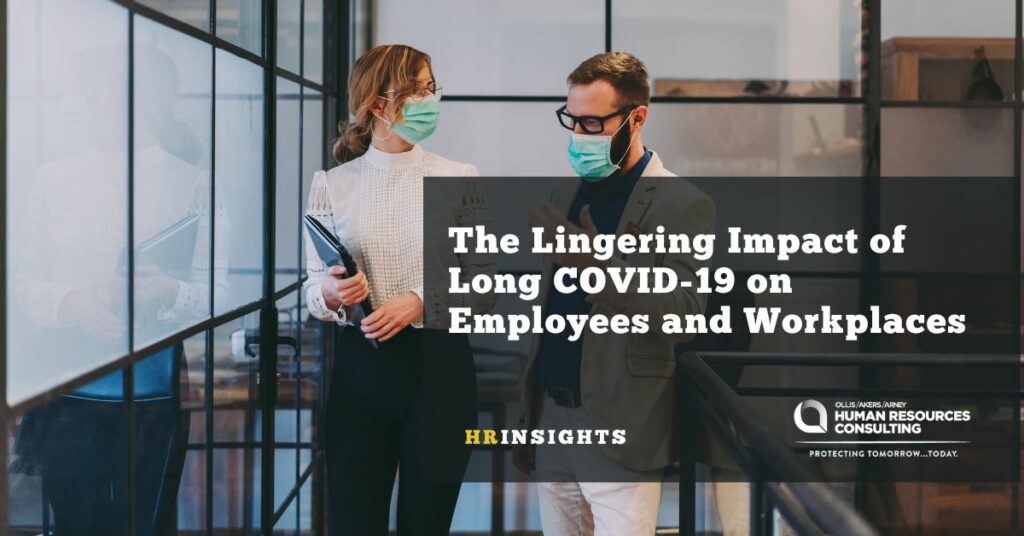Unfortunately, some people who test positive for COVID-19 can experience long-term effects from their infection, known as “long COVID-19.” The effects of long COVID-19 can vary; individuals may experience mild symptoms or suffer near-debilitating health concerns. Long COVID-19 has impacted both employees and their employers. Specifically, some employees have not been able to work at full capacity due to their symptoms, thus creating additional labor challenges for employers. This article further explains what long COVID-19 is, outlines how it has affected employees and explains what this means for employers.
What Is Long COVID-19?
Long COVID-19 can encompass a range of health problems. These symptoms can last for weeks, months or even years, according to the Centers for Disease Control and Prevention (CDC). Generally, such symptoms occur more often among those who experienced severe illness from COVID-19, but anyone who tested positive can encounter long COVID-19—even people who had mild illness or no symptoms from their initial infection. Individuals who have not been vaccinated against COVID-19 and become infected may also be at higher risk of developing long COVID-19.
Per the CDC, people with long COVID-19 commonly report these symptoms:
- Tiredness or fatigue
- Symptoms that get worse after physical or mental activities
- Fever
- Difficulty breathing or shortness of breath
- Cough
- Chest pain
- Heart palpitations
- Brain fog
- Headache
- Sleep problems
- Lightheadedness
- Pins-and-needles feelings
- Changes in smell or taste
- Depression or anxiety
- Diarrhea
- Stomach pain
- Joint or muscle pain
- Rash
- Changes in menstrual cycles
Impact on Employees
The U.S. Census Bureau’s June-July 2022 Household Pulse Survey found that 16.3 million working-age Americans currently have long COVID-19. It has been reported that long COVID-19 is even keeping some employees out of work altogether. In particular, an estimated 4 million workers are currently out of the labor market, according to Brookings Institution’s Nonresident Senior Fellow Katie Bach.
Further, the University of Southern California’s Understanding America Study found that nearly one quarter (24.1%) of individuals who have tested positive for COVID-19 are experiencing long COVID-19; among these individuals, 25.9% reported that their symptoms have affected their employment or working hours.
What This Means for Employers
First and foremost, the lack of available workers and those who are unable to perform at full capacity due to long COVID-19 could be contributing to ongoing labor challenges among employers. In fact, the U.S. Bureau of Labor Statistics (BLS) reported in its Job Openings and Labor Turnover Summary that, in July 2022, the number of job openings across the country rose to 11.2 million, compared to 11 million in the previous month. These openings were well above initial estimates and still outnumbered unemployed workers by about 5.5 million. The number of job openings remains high as the demand for workers outweighs the supply. As such, many employers are struggling to fill positions, and experts expect labor challenges to continue going forward.
Employers will also likely face some challenges as it pertains to their current employees who have long COVID-19. Depending on the symptoms their employees have, employers will likely need to take an individualized approach to properly accommodate them on the job. Common accommodations include reduced hours, remote arrangements and hybrid schedules.
Employers should also be aware that when employees have more severe long COVID-19, this may constitute a disability under the Americans with Disabilities Act (ADA). The ADA makes it illegal for employers to discriminate against qualified individuals with disabilities in all employment practices, such as recruitment, compensation, hiring, firing, job assignments, training, leave and benefits. Employers with 15 or more employees are covered by the ADA. In the scope of long COVID-19, this means that employers are required to accommodate their affected employees as the ADA requires.
The Department of Health and Human Services and the Department of Justice issued joint guidance on long COVID-19 and clarified when it can reach the level of being treated as a disability. Under the ADA, a person with a disability is an individual with a physical or mental impairment that substantially limits one or more “major life activities.” According to the U.S. Equal Opportunity Employment Commission (EEOC), major life activities entail a wide range of tasks, including (but not limited to):
- Caring for oneself
- Performing manual tasks
- Seeing
- Hearing
- Eating
- Sleeping
- Walking
- Standing
- Sitting
- Reaching
- Lifting
- Bending
- Speaking
- Breathing
- Learning
- Reading
- Concentrating
- Thinking
- Writing
- Communicating
- Interacting with others
- Working
As with any ADA request, an employer must provide a reasonable accommodation to a qualified employee or job applicant with a disability, unless doing so would impose an undue hardship on the operation of the employer’s business, according to the EEOC.
For More Information
Long COVID-19 continues to impact employees and workplaces. As a result, employers should monitor the issue so they can be prepared to respond effectively. Employers will likely need to provide accommodations to affected employees who are still able to work and should stay up to date on ADA requirements and other guidelines to ensure they remain compliant. For specific guidance, employers should seek local legal counsel.
For more information on long COVID-19, contact Ollis/Akers/Arney Human Resources Consulting today.
© 2022 Zywave, Inc. All rights reserved






